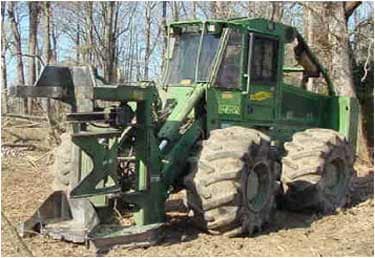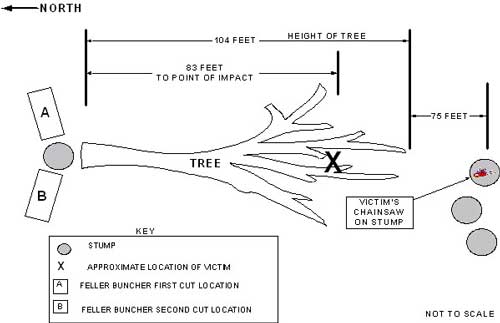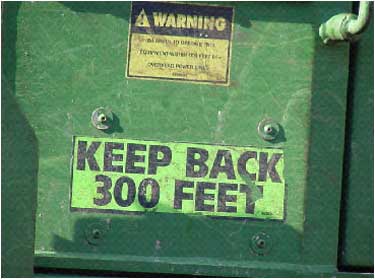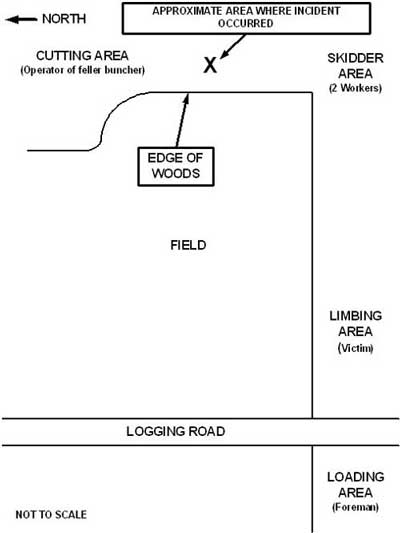Hispanic Logger Struck and Killed by a Falling Tree Cut by a Feller Buncher Machine - North Carolina
NIOSH In-house FACE Report 2004-04
December 17, 2004
Summary
On December 8, 2003, a 23-year-old Hispanic logger (the victim) was struck by a tree cut by a feller buncher machine. After using the feller buncher to make 2 cuts on a tree that was approximately 104 feet in height and approximately 36-inches in diameter, the operator turned to view the tree he had just cut. He observed the tree lying on top of the victim who had been assigned to work in the limbing area. The falling tree struck the victim in the cutting operations area. It is theorized that the victim had been approaching the feller buncher to communicate with the operator. The feller buncher operator ran to the foreman for assistance. When the foreman and the feller buncher operator returned, the foreman was unable to find any vital signs for the victim, and called 911 on his mobile phone. Emergency Medical Services (EMS) and police personnel responded to the scene. The victim was transported by ambulance to a hospital, where he was pronounced dead in the emergency room.
NIOSH investigators concluded that, to help prevent similar occurrences, employers should
- ensure employees understand the importance of remaining a minimum distance of 300 feet from a high speed mechanical- felling operation and not approaching until the machine operator has acknowledged that it is safe to do so
- ensure equipment operators properly use the equipment they are assigned to operate in accordance with manufacturers’ operational guidelines
- ensure that workers are provided with a means of communication on the logging site
- develop a pre-job safety plan for the cutting site which includes hazard recognition and avoidance of unsafe conditions and ensure that it is implemented and reviewed with all workers prior to each day’s cutting
- consider having employees wear high-visibility clothing while working on a logging site
Additionally,
- manufacturers should identify the cutting capacity of the feller buncher and include it on a machine label and in the operator’s manual along with a warning to never double cut trees that are too large to fit into the felling head
Introduction
On December 8, 2003, a 23-year-old Hispanic logger (the victim) was struck by a tree that a coworker cut with a feller buncher machine. On January 19, 2004, officials of the North Carolina Occupational Safety and Health Administration (NCOSHA) notified the National Institute for Occupational Safety and Health (NIOSH), Division of Safety Research (DSR), of the incident. On February 18, 2004, a DSR safety and occupational health specialist conducted an investigation of the incident and reviewed incident circumstances with the NCOSHA safety compliance officer assigned to the case. Photographs of the incident site and witness statements taken by NCOSHA shortly after the incident were reviewed. The county police report was reviewed. No site visit was conducted because the job had been completed. The victim’s employer and the foreman were interviewed by telephone. A telephone interview was also conducted with a service representative from the feller buncher manufacturer. The medical examiner’s report and death certificate were reviewed.
Occupation Background
The Bureau of Labor Statistics’ (BLS) Survey of Occupational Injuries and Illnesses estimated that 1273 timber cutters and loggers were injured in the United States in 2002, and of those injured, an estimated 481 injuries resulted in more than 30 days away from work [BLS 2003].1 Additionally, the Census of Fatal Occupational Injuries (CFOI) data indicated that 104 logging workers died on the job in 2003 and the rate of fatal injuries was 131.6 deaths per 100,000 loggers. The national rate for all occupations in 2003 was 4.0 per 100,000 workers [BLS 2004].2
Employer
The victim’s employer was a privately owned logging company that had been in business for approximately 2 years. The company employed 8 full-time workers; 4 of the workers were of Hispanic origin. The foreman on the job site had been in his position for approximately 2 years, and was a family member of the company owner. The foreman spoke English and limited Spanish. The company had the foreman, a crew of 4 loggers, and 3 truck drivers working on this jobsite at the time of the incident. The employer had only worked the jobsite once prior to the incident. The victim had been working at another logging jobsite before the day of the incident; therefore, it was his first day working at the logging site where the incident occurred. The employer had visited the jobsite the day that work had begun. All of the loggers on the jobsite at the time of the incident were Hispanic.
Insurance company representatives investigating the incident and the NCOSHA compliance officer interviewed the foreman and used an interpreter to obtain and translate statements from three of the Hispanic logging crew members. This was the company’s first workplace fatality.
Victim
The 23-year-old male victim had moved from Mexico to the United States several years prior to the incident and he had been working for the company as a logger for 1 year. The victim’s primary language was Spanish; however, he also reportedly spoke English very well. While working together on the job site, the Hispanic workers spoke only Spanish to each other. However, when the employer and the foreman addressed the Hispanic workers, the victim would translate the English instructions and training into Spanish when warranted. On the day of the incident, the victim was assigned to operate a chain saw to cut trees in the limbing area. The victim was wearing an orange hard hat, chaps, work boots and a dark colored shirt. The employer stated that the workers generally wore orange t-shirts during the warmer months.
Training
The company had a written comprehensive safety program, that was written in English. On-the-job training was provided once a month and as-needed by the foreman or the owner to warn the workers of potential worksite hazards. This training was translated into Spanish by the victim and was documented by the company. One month prior to the incident, training was provided to the workers by a representative from the employer’s insurance agency. The training was translated by the victim and addressed overhead hazards and safely cutting and felling trees. The foreman had completed a 24-hour ProLogger training program that was developed by the State of North Carolina and offered by a local community college. The foreman utilized the materials and information from the ProLogger training program to educate the employees.
Incident Scene
The employer was subcontracted to cut 30-acres of privately owned timber. The timbering operation on the site consisted of four areas; cutting, skidding, limbing, and loading (Diagram 1). The incident occurred in the cutting area where a feller buncher machine was being used to cut trees. The tree that struck the victim was approximately 104 feet in height (from the cut) and approximately 36-inches in diameter at the trunk; the larger branches were approximately 4-inches in diameter.
Equipment
The feller buncher used in this incident is a mobile machine, rubber tired, with a power plant, operator enclosure, and an articulating extendable arm onto which a felling head is attached (Photo 1). The felling head consists of grab arms and a high speeda disc saw. The operator moves the machine into position in front of a tree and maneuvers the felling head to the tree trunk. The grab arms wrap around the tree and the saw severs the tree from the stump. According to a service representative from the machine manufacturer, the grab arms on the model in this incident would expand to hold a tree that is at maximum approximately 18-inches in diameter. The machine then cuts the tree and takes the severed vertical tree with its accumulator arms and lowers it into a horizontal position onto a pile or bunch of trees on the ground.
Weather
It was daylight at the time of the incident, conditions were sunny and clear, and the temperature was in the 40’s.
a The high speed disc saw attachment used in this incident is defined by the saw manufacturer as 1,300 revolutions per minute.
Back to Top
Investigation
The foreman and crew of 4 Hispanic loggers arrived on site at approximately 7:00 a.m. on the day of the incident. This was the foreman’s second time working at this site. This was the victim’s first day working at this particular logging site. Once on the site, the foreman positioned himself to work on the loader in the loading area and assigned the four logging workers to their specific job duties (Diagram 1):
- Work in the skidder area (2 workers)
- Operate feller buncher machine (Photo 1) in cutting area and assist in the limbing area (1 worker)
- Work in the limbing area (victim)
At approximately 9:30 a.m., the feller buncher operator went to assist the victim in the limbing area. While working in the limbing area, the feller buncher operator and victim used chain saws to do ground clearance. At approximately 12:00 p.m., the foreman and the crew of four workers stopped working for lunch.
Following lunch, at approximately 12:30 p.m., the foreman walked around the job site with the feller buncher operator and the victim to discuss what needed to be completed by the end of the day. Approximately 45 minutes later, the feller buncher operator went to the cutting area and begun cutting trees with the machine, while the victim followed the foreman to the loading area to get a replacement chain for his chain saw. After receiving a new chain from the foreman, the victim proceeded towards the limbing area to work. During this period, the foreman reported that he could hear the sound of the feller buncher machine cutting trees.
After cutting approximately five trees, the feller buncher operator attempted to cut another tree. The feller buncher operator approached the tree, which was approximately 104 feet in height and 3 feet in diameter with the machine and made an initial cut on the east side of the tree. In order for the tree to fall, it needed an additional cut, so the feller buncher operator positioned the machine on the north west side of the tree and proceeded to make the final cut (second cut). The feller buncher operator anticipated that the tree would fall in the south easterly direction; however, the tree fell in the south direction.
After the tree fell, the feller buncher operator turned to view the tree lying on the ground and observed the victim lying face down and oriented with his feet to the north and head to the south under the tree (Diagram 2). The tree’s point of impact with the victim was approximately 83 feet in length from where the cuts were made.
Following the incident, the victim’s chain saw was found on a stump, 75 feet beyond the end of tree which struck him. According to police, the victim was believed to have been struck from behind by the tree. Due to the victim’s location and position, the theory suggested by the NCOSHA, is that the victim was approaching the feller buncher operator, most likely attempting to get his attention in order to communicate with him. It is theorized that the victim may have thought that the tree being cut would fall in a different direction from the intended path of the fall. It was also theorized by NCOSHA, that the victim turned away to run, once he saw the direction the tree was falling, and he was struck from behind as he ran.
After turning off the machine, the operator ran towards the loading area to notify the foreman. While operating the loader in the loading area, the foreman observed the feller buncher operator running towards him and waving his arms in the field area. The foreman dismounted the loader and met the operator of the feller buncher in the field. After the operator informed the foreman of the incident, they ran towards the cutting area. Once at the cutting area, the foreman checked and was unable to find any vital signs for the victim. At 2:04 p.m., the foreman called 911 requesting medical assistance on his mobile phone.
At 2:23 p.m., Emergency Medical Services (EMS) and police arrived on the scene. EMS assessed the victim and found that he had an open skull fracture. After not being able to locate any vital signs, the victim was transported via ambulance to a hospital, where he was pronounced dead in the emergency room.
Back to Top
Cause of Death
The medical examiner’s report stated that the cause of death was scalp laceration with an open skull fracture due to blunt force trauma.
Back to Top
Recommendations/Discussion
Recommendation #1: Employers should ensure employees understand the importance of remaining a minimum distance of 300 feet from a high speed mechanical- felling operation and not approaching until the machine operator has acknowledged that it is safe to do so.3-6
Discussion: Workers should always maintain a 300-foot separation between themselves and high speed mechanical felling operations and should not approach until the machine operator has acknowledged that it is safe to do so. Employers should ensure that employees understand that it is sometimes difficult for workers to make their presence known before entering an active felling area, particularly during mechanical-felling operations and/or where ground cover is dense. In such cases, workers must position themselves out of the active falling area and wait for the signal from the feller-buncher operator that the felling operations have ceased and that it is safe to approach. The manufacturer’s operator’s manual states and the feller buncher had warning decals that state “keep back 300 feet” (Photo 2). As a safety precaution, if the terrain is steep and there are workers downslope of the felling activities, this distance should be increased.
Recommendation #2: Employers should ensure equipment operators properly use the equipment they are assigned to operate in accordance with manufacturers’ operational guidelines.3,7
Discussion: Employers should ensure that equipment operators properly use the equipment they are assigned to operate in accordance with manufacturers’ operational guidelines. The employer acknowledged the tree was too large to fit into the feller head, and that was the reason the feller buncher operator had to make two cuts. According to the feller buncher operator’s manual, the proper use of the machine with the feller head saw attachment was to have both the accumulator arms and grab arms opened when approaching a tree. After centering the tree in the attachment, the operator would then depress the grab-arm “Closed” side of the attachment foot pedals to close the grab arm on the tree. Once the tree has been cut, the operator closes the accumulator arm on the tree, and the tree remains in a perpendicular position to the ground while being transported.
According to the Forest Resources Association, mechanized felling reduces worker exposure, thus making a safer, more efficient operation. However, manual felling techniques may be needed to cut trees too large for the mechanical felling machine cutting head.
Recommendation #3: Employers should ensure that workers are provided with a means of communication on the logging site.3,8
Discussion: Employers are required by 29 CFR 1910.266(d)(7)(i) to ensure that “hand signals or audible contact, such as but not limited to, whistles, horns, or radios, shall be utilized whenever noise, distance, restricted visibility, or other factors prevent clear understanding of normal voice communications between employees.”
At each logging operation, the employer should provide and ensure that each worker carries a whistle, a two-way radio, or other means of communication. Whichever device is used, it should be kept readily accessible and checked regularly. According to the employer, on previous work sites, he provided each employee with a two-way radio. However, the radios were not available for use on the day of the incident because they had gotten wet several days earlier and were not working. Workers on the logging site should be issued a means of communication and should receive training on the use and signals that are to be used. However, as a reminder of a good safety practice, when a worker needs to approach a machine operator and is also provided with a means of communication, an acknowledgement from the operator that it is safe to do so is necessary.
Recommendation #4: Develop a pre-job safety plan for the cutting site which includes hazard recognition and avoidance of unsafe conditions and ensure that it is implemented and reviewed with all workers prior to each day’s cutting.9
Discussion: Prior to beginning a logging operation at a new site, a pre-job safety plan should be developed that defines how the site should be logged. Employers should evaluate tasks performed by workers, identify all potential hazards, and then implement and enforce a pre-job safety plan addressing these hazards. In addition, prior to each day’s logging, the loggers should conduct a brief review of the plan and reconfirm each logger’s work area, the direction of the logging and the areas that are prohibited from the workers while the feller buncher is in operation.
A “pre-job safety plan” is an important logger’s tool. A site action plan and daily briefing needs to occur to safely and effectively coordinate logging activities. It is important that the pre-job safety plan be clearly understood, the work areas well-defined, and the potential hazards addressed.
Recommendation #5: Consider having employees wear high-visibility clothing while working on a logging site.10,11
Discussion: High visibility apparel allows workers to be seen more easily. High visibility apparel is defined by ANSI/ISEA as “personal protective safety clothing intended to provide conspicuity during both daytime and nighttime usage.” Loggers should wear brightly colored clothing that contrasts with the environment. The front and back of clothing should have fluorescent trim for daytime use. When working around moving vehicles and equipment, workers should wear high-visibility clothing.
According to the employer, the victim was wearing an orange hard hat, chaps, work boots and a dark colored long sleeve shirt. The employer stated that the workers generally wore orange t-shirts during the warmer months. However, because of cooler weather during the season in which the incident occurred, workers wore jackets sporadically throughout the workday. The owner did not require the workers to wear orange shirts during cool weather. Workers working on logging sites should at a minimum wear a high-visibility vest year-round. High-visibility vests are light weight and could be worn at all times, during any season, and workers could wear the vest over their clothes or jackets to provide better visibility.
Recommendation #6: Manufacturers should identify the cutting capacity of the feller buncher and include it on a machine label and in the operator’s manual along with a warning never to double cut trees that are too large to fit into the felling head.6
Discussion: Manufacturers should identify the cutting capacity and include it on a machine label and in the operator’s manuals, specifications on the size of a tree that the machine can be used to cut while operating the machine properly. According to a service representative from the machine manufacturer, the grab arms on the model in this incident would only expand to hold a tree that is, at maximum, approximately 18-inches in diameter. In this incident, the feller buncher was being used to cut a tree 36-inches in diameter. Due to the size of the tree, the feller buncher had to make 2 cuts to fell the tree. After the final cut, the feller buncher could not hold the tree in a perpendicular position to the ground, due to its size. In the operator’s manual for the feller buncher used in this incident, there was no mention of any specific tree size limitations for the feller buncher. Labeling the machine with size limitations for cutting and carrying would also help ensure the machine is used as designed. The manual only provides a caution “to avoid carrying trees which are too large for the machine and/or attachment.”
According to a safety manual on feller bunchers produced by the Equipment Manufacturers Institute, a recommendation is made to “Never” double cut trees that are too large to fit into the felling head.
Back to Top
References
- BLS [2003]. Occupational Injuries and Illnesses: Counts, Rates, and Characteristics, 2002. Washington, DC: U.S. Department of Labor, Bureau of Labor Statistics, Bulletin 2566.
- BLS [2004]. National Census of Fatal Occupational Injuries in 2003. Washington, DC: U.S. Department of Labor, Bureau of Labor Statistics, News No. 4-1830.
- Manufacturer’s Operator’s Manual. 2001.
- NIOSH [1995]. NIOSH Alert: “Preventing Injuries and Deaths of Loggers”. Cincinnati, OH: U.S. Department of Health and Human Services, Public Health Service, Centers for Disease Control and Prevention, National Institute for Occupational Safety and Health, DHHS (NIOSH) Publication No. 95-101.
- Code of Federal Regulations 2004 edition. 29 CFR 1910.266(h)(1)(iv) Tree Harvesting. U.S. Printing Office, Office of the Federal Register, Washington, D.C.
- Equipment Manufacturers Institute [1998]. Feller/Buncher. Chicago: Illinois: EMI Publishing Form #BL 98-1.
- Forest Resources Association [2001]. Timber Harvesting Safety. Rockville, Maryland.
- Code of Federal Regulations 2004 edition. 29 CFR 1910.266(d)(7)(i). Logging Operations, General Requirements. U.S. Printing Office, Office of the Federal Register, Washington, D.C.
- Code of Federal Regulations 2004 edition. 29 CFR 1910.266(i)(3)(iii) Logging Operations, Training. U.S. Printing Office, Office of the Federal Register, Washington, D.C.
- Anonymous. Fallers’ & Buckers’ Handbook 2001 edition. Vancouver, BC: Workers’ Compensation Board of British Columbia.
- ANSI/ISEA [1999]. American National Standard for high-visibility safety apparel. New York, NY: American National Standards Institute, ANSI/ISEA 107-1999.
Back to Top
Investigator Information
This investigation was conducted by Nancy T. Romano, Safety and Occupational Health Specialist, Fatality Investigations Team, Surveillance and Field Investigations Branch, Division of Safety Research.
Back to Top
Photographs

|
|
Photo 1. Photo of feller buncher.
Photograph courtesy of the NCOSHA. |

|

|
|
Photo 2. Hazard warning on the feller buncher in this incident.
Photograph courtesy of the NCOSHA. |

